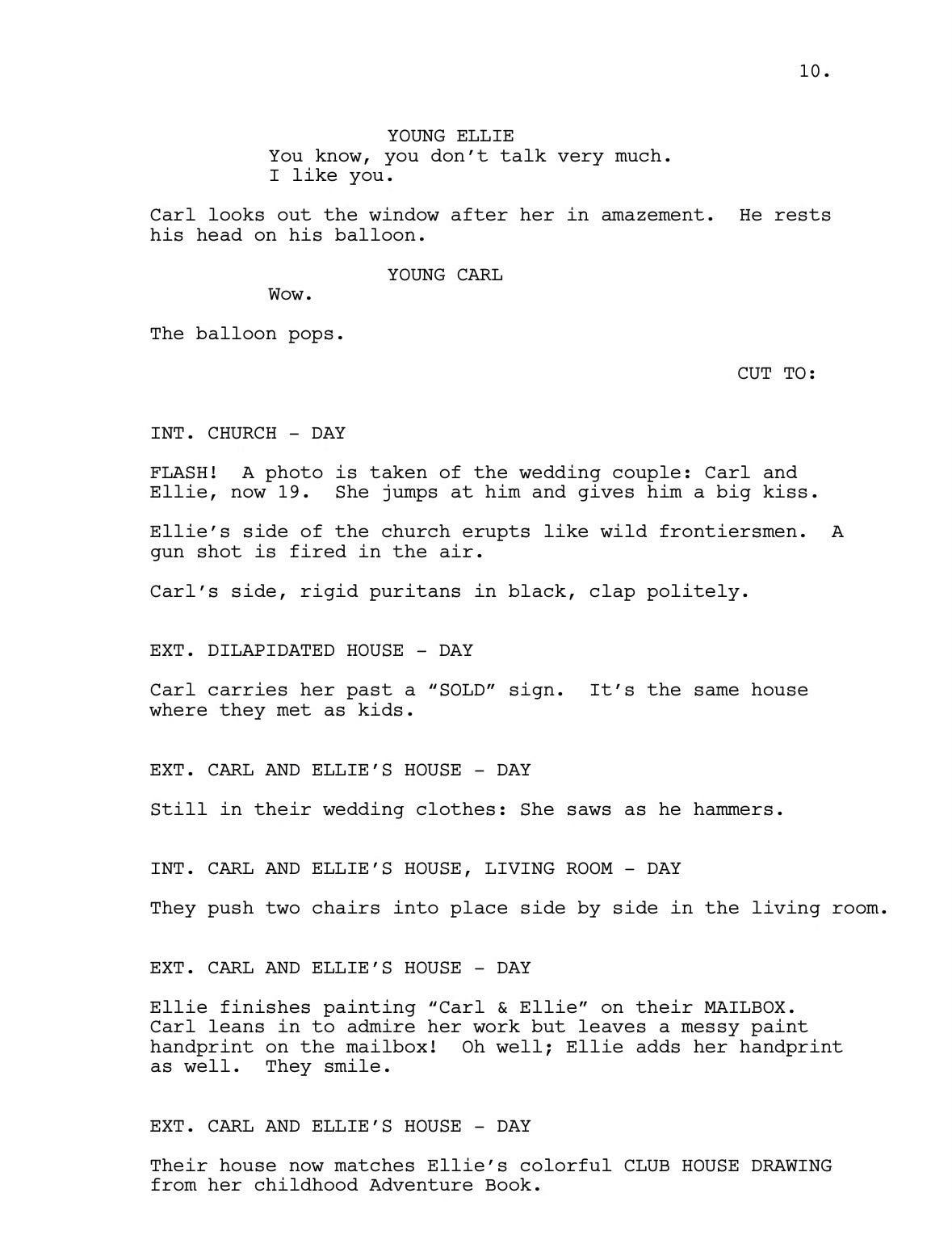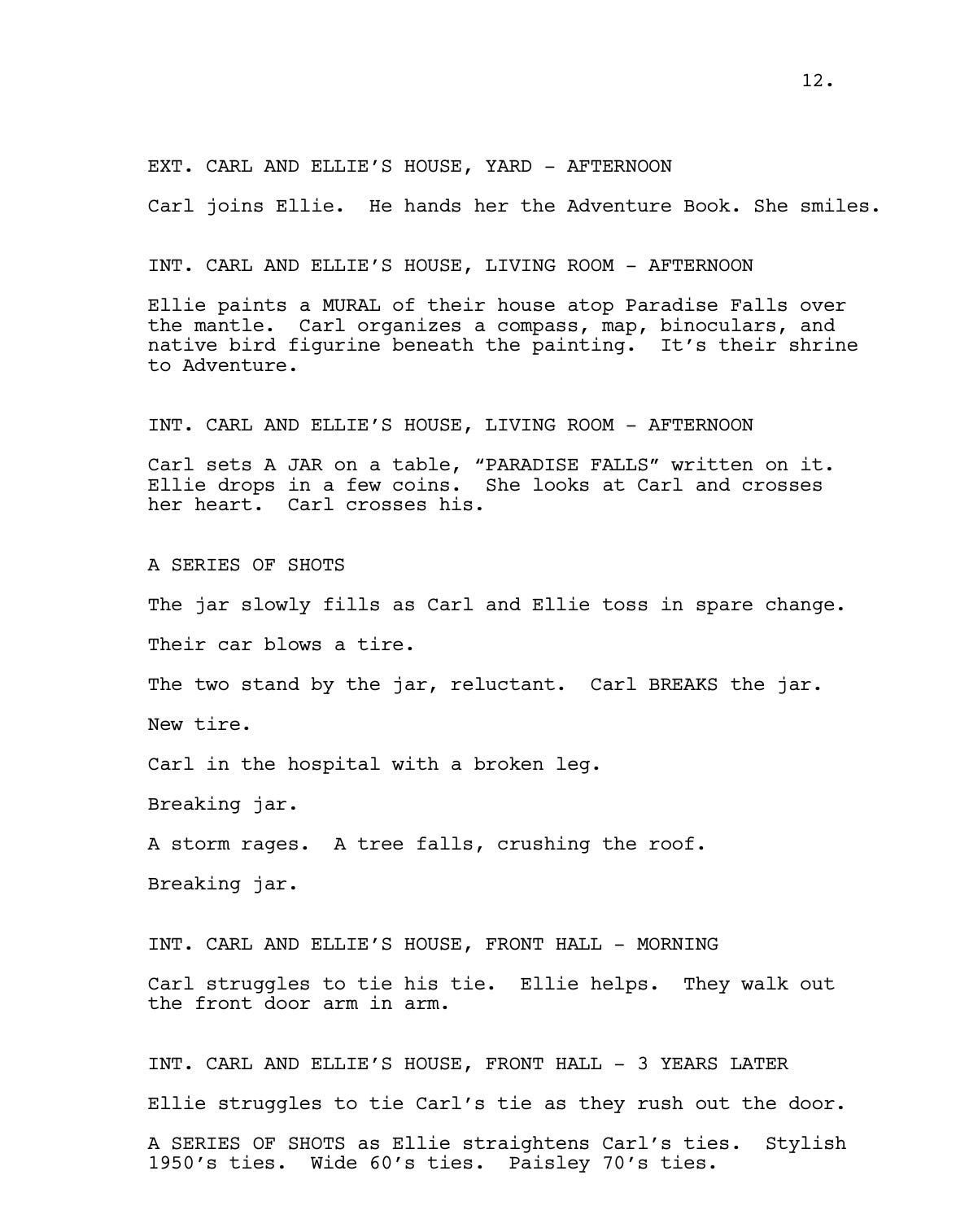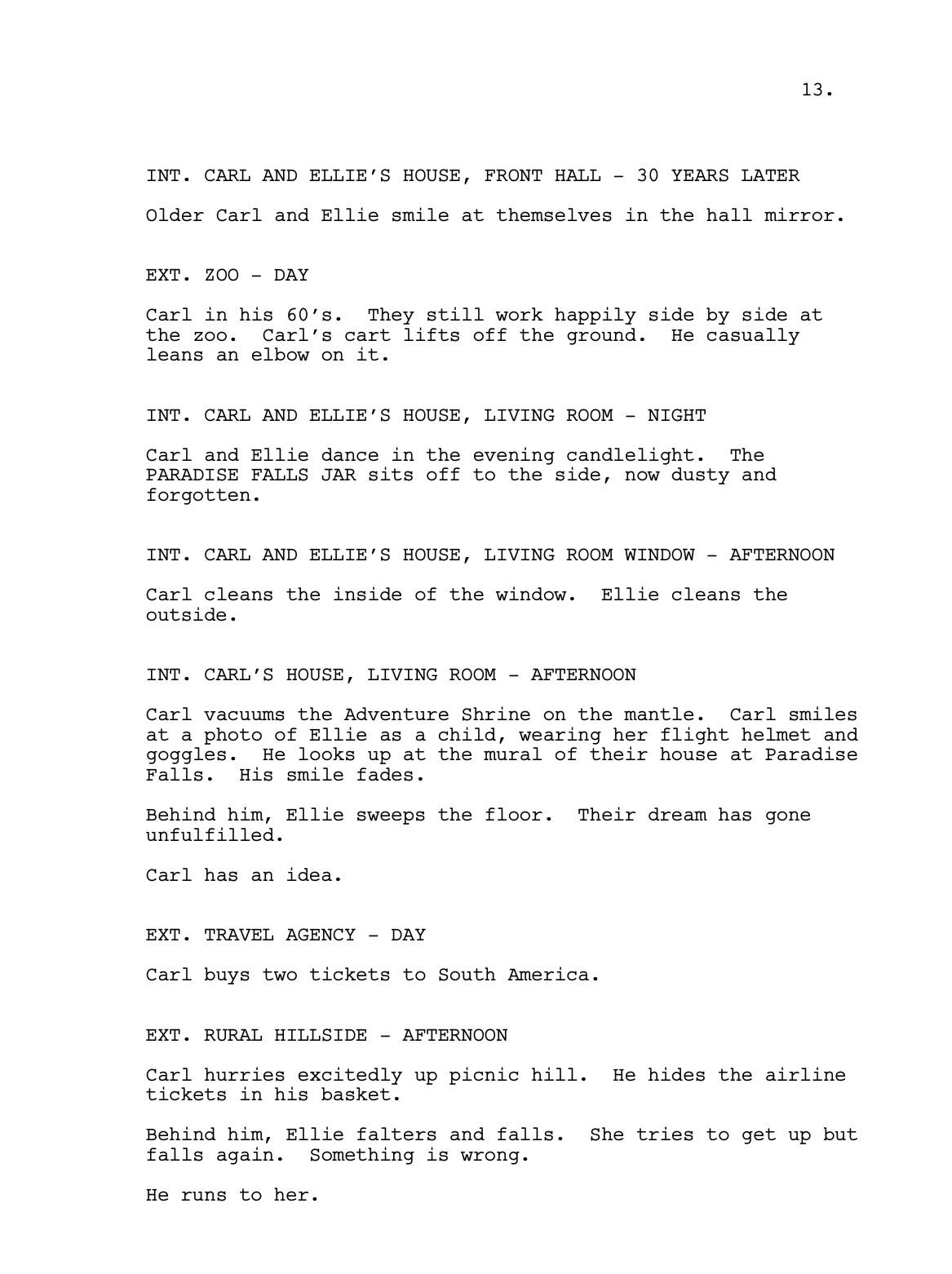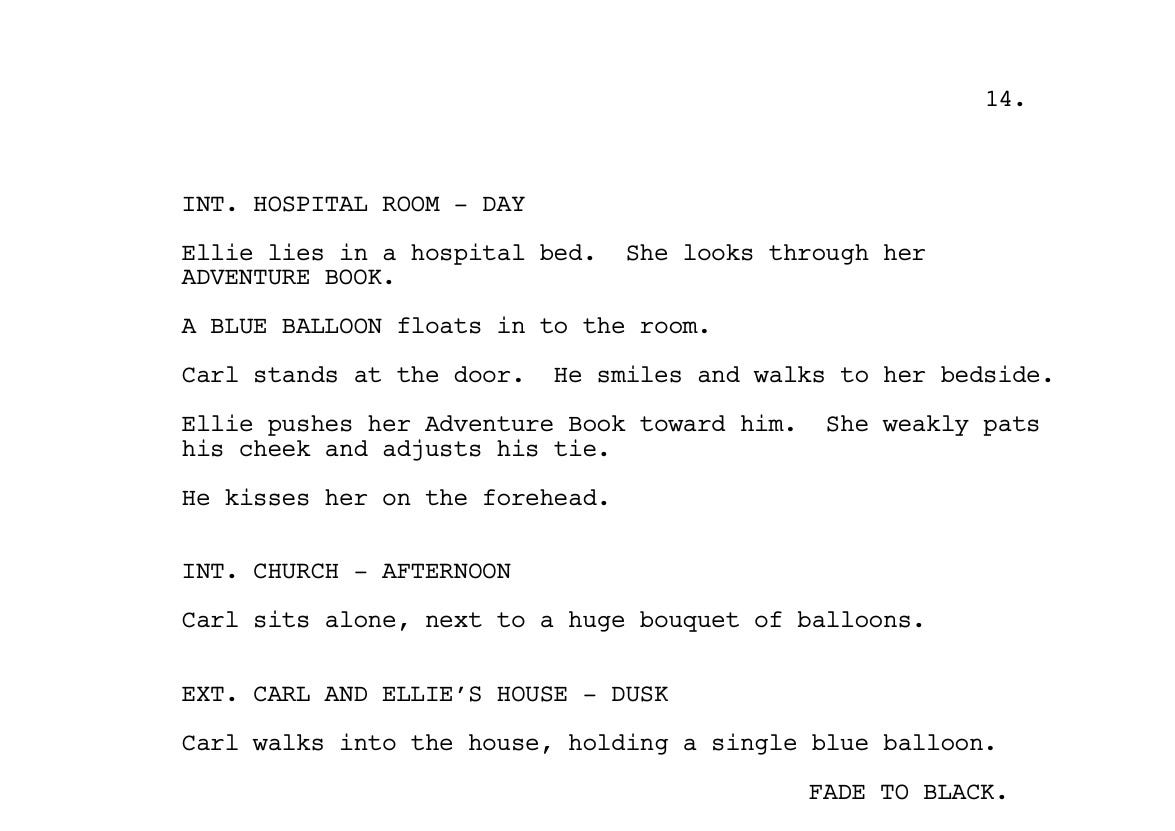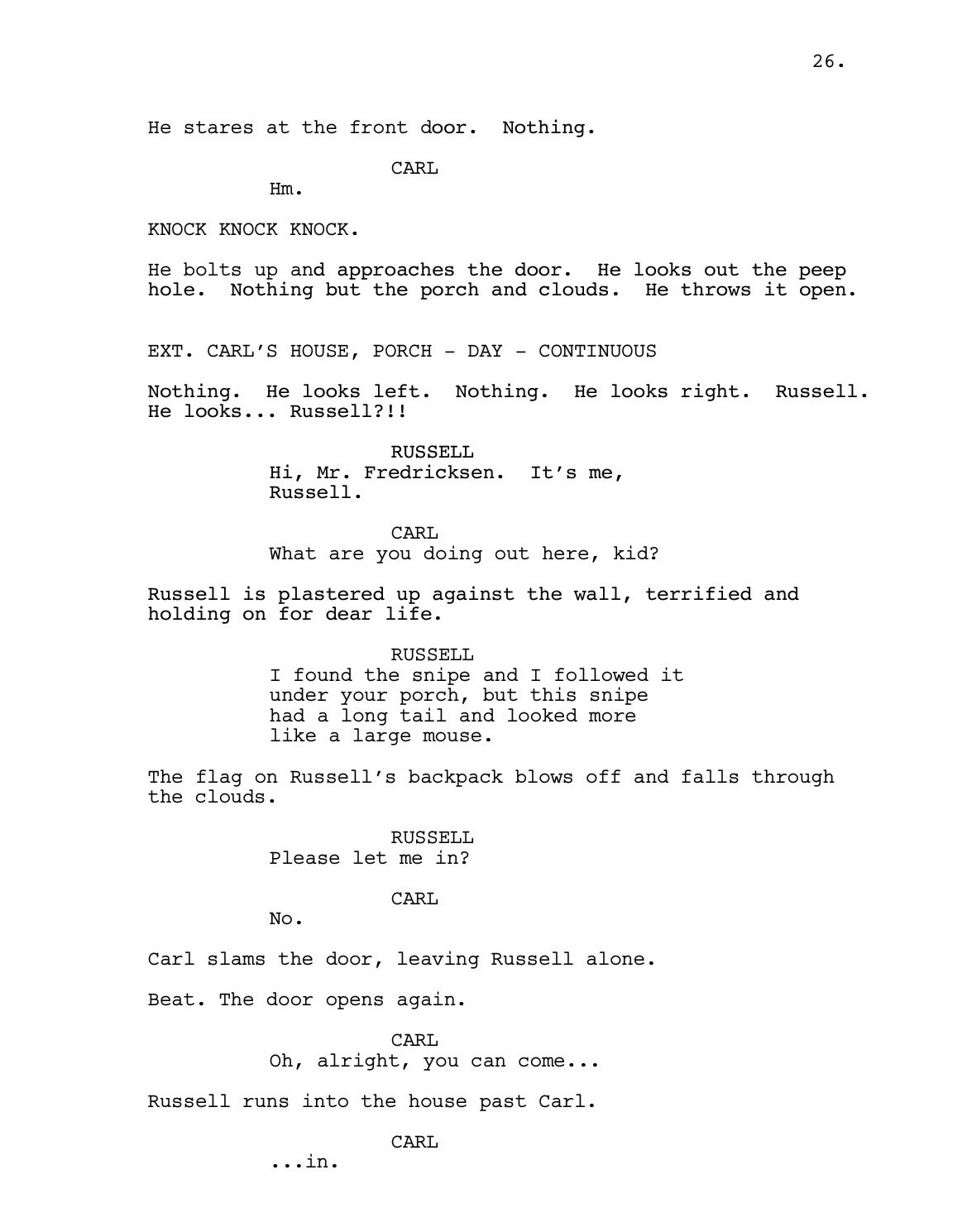Up (2009) Script Review | #33 WGA 101 Greatest Scripts of the 21st Century
A lively fantastical adventure overshadowed by a montage that is cinema at its finest.
Logline: Carl Fredricksen spent his entire life dreaming of exploring the globe and experiencing life to its fullest. But following the death of his wife, life seems to have passed him by, until chance (and a persistent 8-year old Wilderness Explorer named Russell) allows him to fulfil a life-long dream of traveling to Paradise Falls by equipping his house with balloons, and find a new lease on life.
Written by: Bob Peterson, Pete Docter
Story by: Pete Docter, Bob Peterson, Tom McCarthy
Pages: 100
When I think of Up, I remember that scene. The one that captures an entire marriage and life lived in a single montage, that concludes with such devastating power that you almost forget that this is the story about an old man, a young boy, a flying house, a mythical bird, and a talking dog. That’s all fine, but that montage I mentioned earlier? It’s magic.
Up is the story of Carl Fredricksen. Once upon a time, he dreamt of adventure, inspired by the legendary explorer and boyhood idol, Charles Muntz. In Ellie, Carl finds a companion who yearns to move to Paradise Falls, a fantastical place somewhere in South America. Like most dreams, they get shunted to a side as more pressing daily matters take precedence. Time passes, Carl and Ellie grow old; before Carl gets a chance to give Ellie her abandoned adventure, she dies. Devastated, Carl retreats into the world. Their relationship and their years are the subject of the aforementioned montage; a mere four-and-a-half pages, but what a brilliant four-and-a-half pages.
When Carl is forced to go to a retirement home after an encounter with a construction worker, he has other ideas. Carl, who worked as a balloon-man his entire life, outfits the house with a million helium-filled balloons that can carry it all the way to Paradise Falls; he wants to honor Ellie’s promise.
Yet so much for the best laid plans of mice and men. Carl has a stowaway, an eight-year-old Wilderness Explorer named Russell. Russell needs to get his ‘Assisting the Elderly’ badge to become a Senior Wilderness Explorer; Carl wants to be left alone. On top of this, the pair are stalked by an unusually tall bird once they land. The bird takes an exceptional liking to Russell; the feeling mutual, Russell calls the bird Kevin. In turn, this leads them to a talking dog named Dug. Dug belongs to Charles Muntz, incredibly still alive and in pursuit of finding proof of a tall mythical-looking bird that once cost him his reputation when he was younger. Wouldn’t you know, the bird looks awfully similar to Kevin! Carl, who only wanted to keep a promise, is caught up in a bigger adventure than he bargained for— and in the process, finds himself quickly becoming protective of Russell.
The screenplay, credited to Bob Peterson and Pete Docter, is lean and trim; clocking in at an even 100 pages, it hasn’t an ounce of fat on it. The story moves at a brisk pace; by page 24, Carl has flown away in the house; another 10 pages later, the old man and young boy have reached the South American continent. By keeping the journey to Paradise Falls short, Peterson and Docter are able to spend the time instead on the characters. These include a scene where Carl begins to soften towards Russell when he realizes that the young boy—the son and grandson that he and Ellie could never have—comes from a single parent household and has a mostly absent father…
… or when Carl realizes that Ellie considered their life together an adventure, and left him a note—perhaps at the time she was dying— to go have a new adventure.
(Seriously, simply thinking about the Carl-Ellie scenes is enough to make my eyes well up.)
Reading the Up screenplay, I’m struck by the fact that it is very much a genre story; it’s got shades of The Wizard of Oz with a tinge of the Indiana Jones franchise and even Fitzcarraldo (the Werner Herzog film about a man who moves a house through a mountain). But at its heart is a story about learning to live again and find meaning after the death of a loved one. It’s rare to have a feature script in which an old man is the main character; rarer still when it finds ways to depict a lifetime of love in such a moving manner.
This is a prime example of building a genre story such as this around humanistic characters and emotions instead of focusing too narrowly on plot. Narrative isn’t necessarily why people come to the movies or enjoy reading a screenplay; they do it because they want to connect with it.
I’m also beginning to understand why the early 2000s were Pixar’s watershed years. Before the sale to Disney, the creative teams were given a great deal of time to work through the stories or even change direction altogether. This is something that is rarely possible under corporate pressure. Ratatouille was rewritten in the three years prior to its release; WALL-E went through several changes to arrive at its final version. Both pictures were greenlit before the acquisition. Inside Out is the rare anomaly in which the filmmakers (again, Pete Docter) overhauled a crucial plot point two years before the release date under the Disney regime. Up was a particularly difficult baby; the earliest visions bear no resemblance to what ended up on screen. It started as a story about a king who lived in a castle up in the sky, and his two sons who fell to Earth and were forced to cooperate when they encountered a tall bird. But the rules of this world were too complicated, the sons too spoiled for the audiences to empathize with, and so they went back to the drawing board; only the title and the tall bird would remain.
Facing a blank page, Docter thought hard about what he was trying to express. He remembered daydreams of running away when overwhelmed; and a sketch of an old man with a bunch of balloons. His second iteration of Up bore a closer resemblance to the story we now know; except Carl and Russell landed in an abandoned Soviet-era spy dirigible that was camouflaged to look like a giant cloud. Everyone was enthusiastic about this new version… until someone pointed out that Pixar had already optioned a story about a giant cloud and could be challenged for copyright infringement.
Out the window, too, went this version.
In the third iteration, they paid attention to Kevin. Why was this bird being pursued? Answer: its eggs granted youthfulness to those who ate it. Once again, the mythology created too many problems. In the fourth pass, the team omitted mentioning the eggs. If there were any fears about audiences wondering how Charles Muntz was pretty spry for someone who was nearly 100-years-old, they soon were put to rest; people were too absorbed in the story to care. Still, it took years before Docter was happy. He drilled down the characters’ emotional arcs and then built the story around them; or as his mentor, the legendary Joe Grant, said: make sure the characters have an ‘emotional bedrock.’
Total time spent to lock the script: three years.
In that time, Tom McCarthy (Spotlight) contributed for three months while Peterson temporarily moved to help out Ratatouille. McCarthy gets a Story by credit for his suggestion of creating a foil for Carl. Although it took several years to assemble the script, Docter’s willingness to keep exploring and his patience to keep drilling the story allowed the team to explore new ideas; his willingness to explore and roll with the failed iterations led to the story we are reading today. Perhaps that’s why only one entry from Pixar’s filmography post-2010 (Inside Out) made the cut for the WGA List of Greatest Screenplays of the 21st Century; everything other entry on the list was written between 2000 and 2010.
Up falls into that category of story in which emotionally dead men find a new sense of purpose, such as Casablanca and A Christmas Carol. Some of the earlier story versions included a plot in which Carl wanted to join his wife in the sky; but the suicidal undertones were deemed problematic. Worse, they did not move the story. Before Russell— the pivotal character from whom Carl learns about himself and the way he inspires the older man— there was Dug, a talking dog brought in from an unmaterialized project in order to give Carl someone to talk to.
With plenty of lively writing— for instance, the way they write a double-take—
By building the story around the characters, and taking the time to discard through bad versions of possible ideas, Up is proof that it is possible to not only cook up an exciting fantastical adventure, it is possible to find truly transcendental moments even in a genre story. You just have to work at it.
Notes:
Ben Block, Alex (November 17, 2009) | Anatomy of a Contender: ‘Up’ (The Hollywood Reporter)
The Hollywood Reporter (May 12, 2009) | Q&A: Pete Docter (The Hollywood Reporter)
Catmull, Ed; Wallace, Amy (2014) | Creativity Inc.: Overcoming the Unseen Forces That Stand in the Way of True Inspiration




